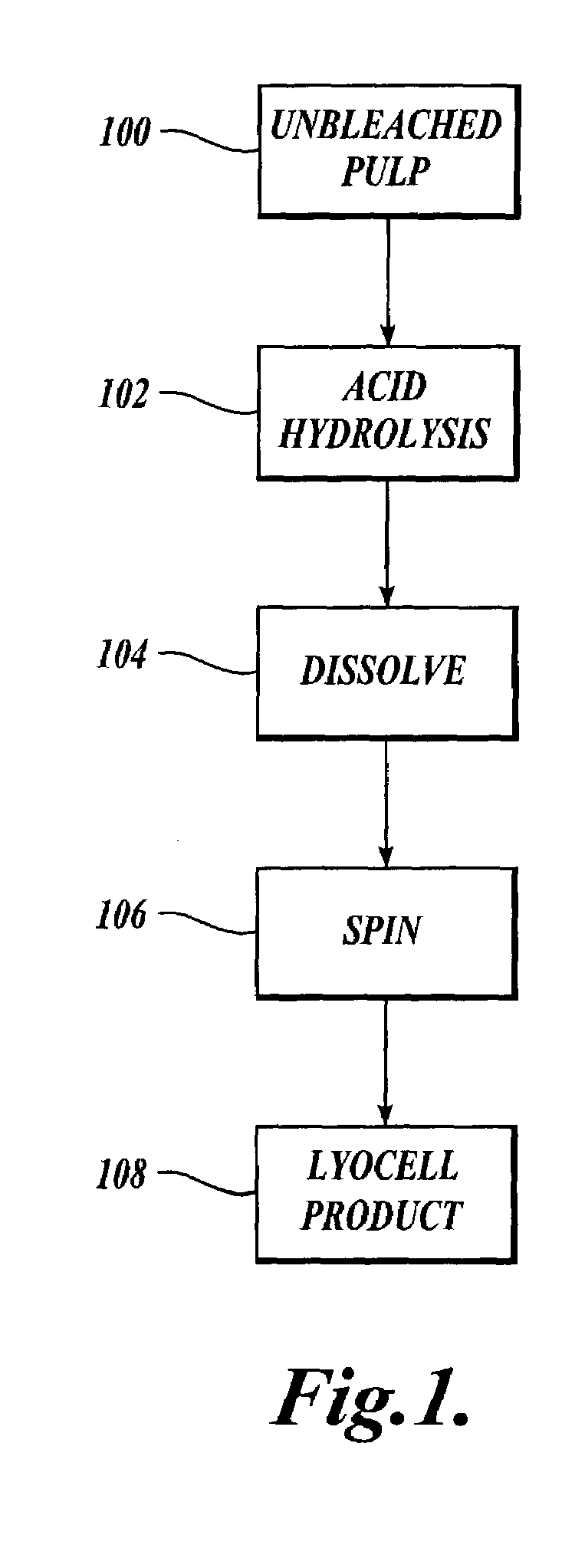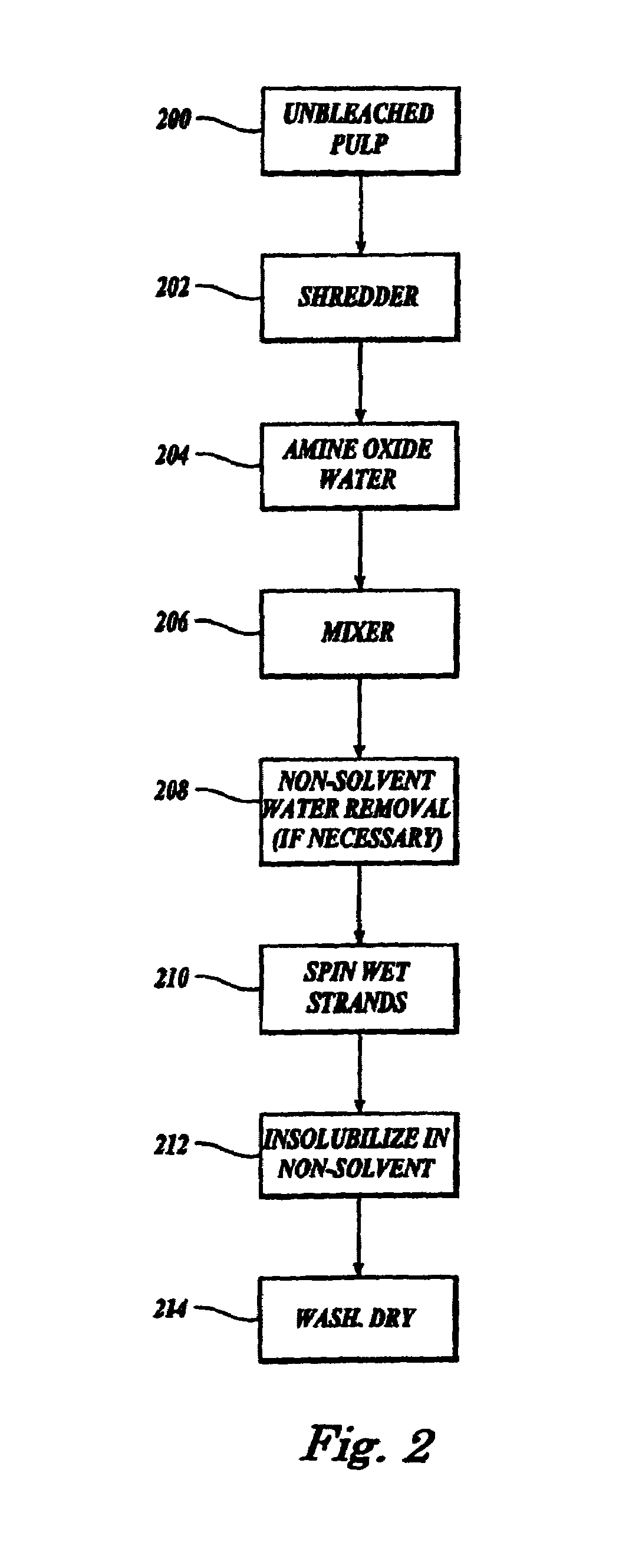Method of making a modified unbleached pulp for lyocell products
a technology of lyocell fiber and unbleached pulp, which is applied in the field of making lyocell products from unbleached pulp, can solve the problems of significantly reducing the yield of lyocell fiber and products manufactured therefrom, significantly increasing the cost of this form of cellulose fiber, and reducing the average degree of polymerization of cellulose. , the effect of improving the overall yield
- Summary
- Abstract
- Description
- Claims
- Application Information
AI Technical Summary
Benefits of technology
Problems solved by technology
Method used
Image
Examples
example 1
Dry-Jet Wet and Meltblown Spinning Process Conditions
[0061]Lyocell fibers were produced using laboratory process equipment from both the Thuringisches Institut Fur Textil Und Kunststoff-Forschung (TITK) and the Weyerhaeuser Technology Center (WTC). Table 1 illustrates some of the process conditions used for the dry-jet wet and meltblowing methods.
[0062]
TABLE 1TITK lab processWTC lab processWTCBasic condition(DJW)(DJW)meltblownNozzle diameter75–9080450(micron)Spinning temperature85–9090–10590–105° C.Winder speed (m / m) 70–10060–100>200Bath temperature4–520–30 20–30 ° C.(water / NMMO(water)(water)mixture)
[0063]It was found that the average diameter of the WTC dry-jet wet lyocell fibers from modified unbleached Kraft is about 12 microns, and the fibers have a denier of about 1.3. The diameter distribution is shown in FIG. 11. As can be seen from FIG. 11, the diameter of the dry-jet wet lyocell fibers from the modified unbleached Kraft pulps had some variability. The variability may have c...
example 2
Mechanical Properties of the Dry-Jet Wet Lyocell Fibers
[0064]An Instron tester was used to measure the mechanical properties of the WTC dry-jet wet lyocell fibers. The properties are shown in Table 2.
[0065]
TABLE 2TensileTensileMax.ElongationEnergyTensile atLoadat Max.AbsorptionMax. LoadMOEWidth(kgf)Load (%)(J / m{circumflex over ( )}2)(kN / m)(GPa)(mm)30 MM GAUGE LENGTH0.0487.44214729.3640.990.0160.0288.58177424.7729.440.0110.0295.86127120.4040.990.0140.0559.32357536.2454.850.0150.0304.21142319.5725.870.0150.0345.46101122.2948.440.0150.0304.91119322.6853.380.0130.0336.91195229.0799.270.0110.0426.71207637.69126.300.011Mean:0.0386.86182527.6056.920.014Std Dev:0.0101.787736.6631.580.002COV:27.24526.04224.1255.4814.37510 MM GAUGE LENGTH0.08312.82720174.0758.580.0110.0979.58709086.1659.680.0110.0478.72411846.2076.110.0100.06511.07567963.5855.320.0100.0539.11476351.73152.600.0100.0449.2434.8642.7841.820.0100.06812.71629866.7324.520.0100.0288.16104221.1629.460.0130.07312.27566450.9639.810.0140...
example 3
Diameter and Lignin Content of Meltblown Lyocell Fiber From Modified Unbleached Pulp
[0069]Using the meltblown spinning system from WTC, lyocell fibers from modified unbleached Kraft pulp were obtained. The meltblown lyocell fiber had 3.4% of Klason lignin and the diameter results are summarized in Table 3.
[0070]
TABLE 3SampleWTC-1WTC-2WTC-3WTC-4PulpAcid hydrolyzed unbleached Kraft pulpThroughout / hole (g / m)2.01.00.500.25Average diameter (micron)28.2420.1717.6211.84Standard deviation (micron)4.862.882.371.65COV (%)0.170.140.130.14Klason Lignin (%)3.4
[0071]As expected, the diameter of the lyocell fiber decreased with decreasing throughput. The diameter will also be affected by air pressure, temperature, and winder speed, etc. For meltblown lyocell fibers, diameter distribution is usually broader than those from dry-jet wet process. FIG. 12 shows the diameter distribution of meltblown lyocell fiber from modified unbleached Kraft pulp. As can be seen from FIG. 12, meltblown lyocell fibers...
PUM
| Property | Measurement | Unit |
|---|---|---|
| Fraction | aaaaa | aaaaa |
| Fraction | aaaaa | aaaaa |
| Fraction | aaaaa | aaaaa |
Abstract
Description
Claims
Application Information
 Login to View More
Login to View More - R&D
- Intellectual Property
- Life Sciences
- Materials
- Tech Scout
- Unparalleled Data Quality
- Higher Quality Content
- 60% Fewer Hallucinations
Browse by: Latest US Patents, China's latest patents, Technical Efficacy Thesaurus, Application Domain, Technology Topic, Popular Technical Reports.
© 2025 PatSnap. All rights reserved.Legal|Privacy policy|Modern Slavery Act Transparency Statement|Sitemap|About US| Contact US: help@patsnap.com



